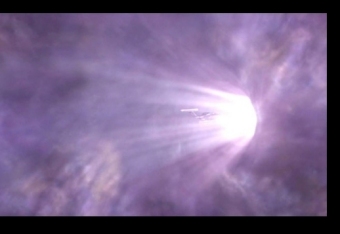
In Star Trek, a subspace corridor is a wormhole-like
passage through subspace, which allows a starship to travel over great
distances in a short time. In the 21st century, there was a subspace
corridor in the Delphic Expanse, extending 11.6 light years from a
nebula controlled by the Kovaalans to not far from the Xindi Council
planet. In February of 2154, Enterprise used this corridor to travel
quickly to the Council planet. (ENT: "E²")
In an alternate timeline, Enterprise traveled through
the corridor with a damaged impulse manifold. The particle wake
destabilized the corridor, causing it to shift in time. The ship
emerged in the year 2037. Fortunately, this was avoided when that
Enterprise assisted the 2154 version of the ship in making alterations
to the impulse manifold.
There is a vast network of subspace corridors in the
Delta Quadrant known as the Underspace. The Vaadwaur discovered and
charted the Underspace, using them to travel throughout the Delta
Quadrant. In 2376, the Federation starship USS Voyager's warp field
interacted with one of the corridors, and it was pulled through a
breach in the radial wall. The Turei expelled them from the corridor,
but then demanded to board Voyager to eliminate all evidence of the
Underspace. The Vaadwaur offered to cooperate with Voyager, to show
them corridors of which the Turei have never been aware. However, their
desire to regain their former power ultimately led them to attempt to
capture Voyager and its advanced technology. Voyager defeated them with
help from the Turei, and the remaining Vaadwaur ships fled into the
Underspace. (VOY: "Dragon's Teeth")
In 2377, Reginald Barclay speculated that a group of
Ferengi may have found either a wormhole or a subspace corridor to
bring Voyager to the Alpha Quadrant, before realizing that they were
planning to utilize a geodesic fold. (VOY: "Inside Man").
The closest equivalent to subspace corridors in
astrophysics appear to be wormholes and may in fact be subspace
equivalents of wormholes in normal space. It is not explained what
makes subspace corridors different from other wormholes encountered in
the Star Trek world. The theory developed by Fabrice Petit of the
Belgian Ceramic Research Centre and Michael Sarrazin of the
Facultés Universitaires Notre-Dame de la Paix, in Belgium, in
September 2007 certainly describes what amounts to shortcuts through
extra 'subspace' dimensions.
|
